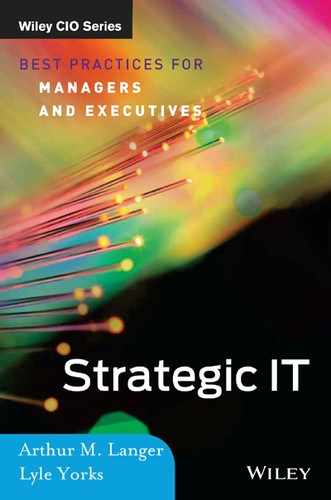Foreword
After a 44-year career at IBM, I have experienced many changes in the information technology (IT) industry and how firms struggle to understand the value of IT in general. After all those years, many of the controversies are still discussed at board meetings today. What is most troubling is the ongoing debate over the role of the CIO: who should CIOs report to, their specific responsibilities, and whether they can contribute strategically to the business.
Drs. Langer and Yorks's book, Strategic IT: Best Practices for Managers and Executives, deals with the issues that all CIOs faces no matter where they work. Independent of geography, size, business, or purpose, the constant, critical question facing each and every CIO in the twenty-first century is this: Are you a cost or are you an investment? That is, are you part of the business tactics or part of its strategy? Langer and Yorks have written the complete CIO survival handbook for thriving in this fast-paced and rapidly changing world. Langer and Yorks remind us that change is the norm for CIOs and that time to change is not an ally; rather, speed and demand typically dictate the environment CIOs call home.
Drs. Langer and Yorks use the rich data made available to them from Columbia University where they hold CIO workshops and teach in the Executive Master of Science program in Technology Management, therefore, much of their experience with CIOs and students back up their theories and coursework. Their real-world examples bring life to the A–Z framework of success. Indeed, I have witnessed the excitement of participants at their lectures.
Based on my experience, Langer and Yorks touch on the critical issues facing CIOs today. While CIOs must be experts in technology, have organizational skills, contribute to the bottom line, and have executive presence, the more vital skill today is their need to be an enabler of innovation and a change agent in their firms. Whether we're talking about a large or small enterprise, a for-profit or not-for-profit organization, the CIO's success is all about understanding change. The only way to help transform organizations is by having a very agile and focused IT strategy. As a director on a number of boards, I understand the complexity of dealing with the multiple perspectives on how to use information technology. I hear all of the different opinions about the value of big data, mobile applications, mobile devices, cyber security, and cloud computing, just to name a few. What is most challenging is that all of these new technologies develop and change in the wink of an eye. Yet little, if any, of these new technologies were discussed, let alone needed, five years ago. And what will be needed five years from now is truly a mystery to most enterprise leaders today.
For all these reasons and many more, Langer and Yorks's definition of the successful CIO in Strategic IT is spot-on. So much of an organization's success depends on whether the CIO and the leadership team work closely together and have a shared vision of the business. Strategic IT will give CIOs more than a fighting chance to make a difference in their organizations—a difference that most of them want to accomplish but they need the tools to survive and thrive in today's fast-paced world.
—Nicholas Donofrio,
IBM Fellow Emeritus & Executive Vice President,
Innovation and Technology (Ret.),
NMD Consulting, LLC
